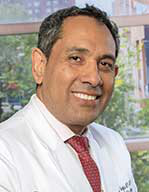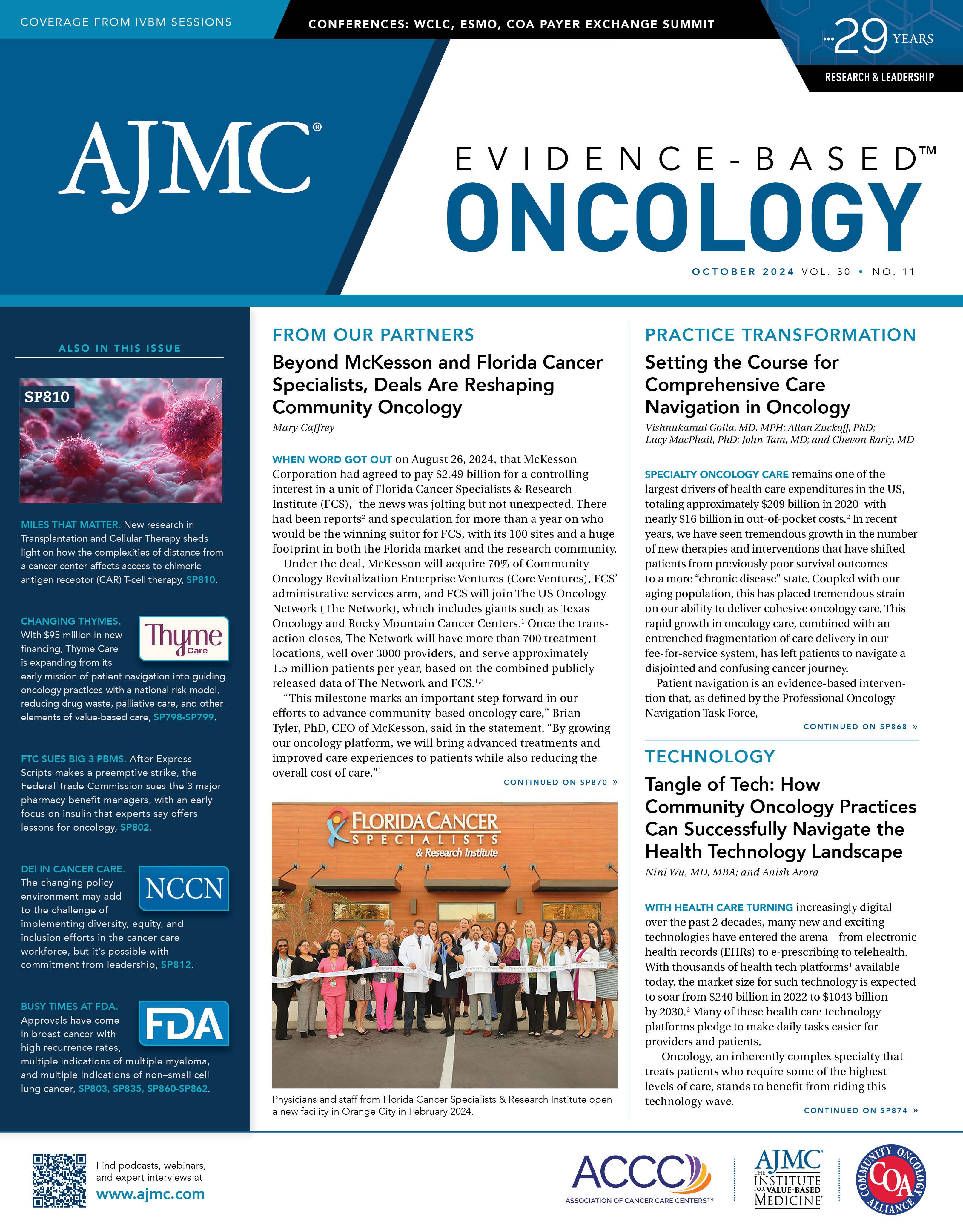- Center on Health Equity & Access
- Clinical
- Health Care Cost
- Health Care Delivery
- Insurance
- Policy
- Technology
- Value-Based Care
Miles Matter: The Geographic Disparity That Impacts Access to CAR T Therapy
From his cancer clinic in downtown Philadelphia, Pennsylvania, Usama Gergis, MD, MBA, can see New Jersey just across the Delaware River. However, for many of his patients living mere minutes away, that state line might as well be an impassable barrier. Because of insurance
restrictions, instead of receiving chimeric antigen receptor (CAR) T-cell therapy at Gergis’ nearby facility, some patients must travel hours to centers within their home state. This means some forgo the treatment altogether, settling for options that may be less effective.
Patients in Camden County, New Jersey, who live less than 20 minutes from Philadelphia, Pennsylvania, may be unable to access CAR T-cell therapy in that city due to insurance restrictions. Instead, they are required to travel more than 2 hours each way to New Jersey facilities, physicians say. | Image credit: Thomas Jefferson University

“You’re nauseous, tired, fatigued, [and] full of uncertainties,” said Gergis, professor of medical oncology and director of bone marrow transplant and immune cellular therapy at Thomas Jefferson University. “You’re dealing with cancer, and now your state that you’re paying taxes to tells you, ‘No, you cannot cross the bridge and go to the transplant center 10 minutes away. You need to drive 2 hours each way in New Jersey traffic.’”
Usama Gergis, MD, MBA | Image: Thomas Jefferson University

The topic of which socioeconomic factors determine who receives CAR T is of great interest to Gergis, so he and colleagues examined this question and recently published a study1 identifying the significant disparities in access to
CAR T therapy for patients with relapsed or refractory large B-cell lymphoma. They looked at data from more than 5000 patients who were eligible for CAR T and compared the characteristics between the more than 600 patients who received the treatment and those who didn’t.
The research, published in July in Transplantation and Cellular Therapy, found that factors like age, race, and income impact whether patients receive these therapies. Surprisingly, proximity to a treatment center also played a crucial role. According to their data, patients living 2 to 4 hours away from the nearest CAR T treatment center were nearly 40% less likely to receive the therapy compared with those living within 30 minutes.
“We mapped the distance, and it turned out that if you live 2 to 4 hours away from a transplant or therapy center, you are way less likely than if you live closer” to receive CAR T, Gergis said. They found no significance between people who lived 30 minutes away and those who lived more than 4 hours away. Gergis interprets this as meaning patients will either travel locally or relocate for a longer distance, but for longer drivable distances, patients sought other therapies closer to home.
The issue is not one that solely impacts patients in New Jersey or those on state Medicaid plans; some private insurers and employee-sponsored health care plans have preferred treatment locations, Centers of Excellence (COEs), or other restrictions regarding where patients can receive these therapies. Employers are increasingly turning to these types of programs, which include bundled payments and warranties, as the cost of care and incidence of cancer continue to rise, according to a report2 by Carrum Health and PwC on the state of the market for COEs. The report also stated that the national incidence of cancer in people younger than 50 years is expected to rise 31% by 2030, with treatment spending rising to $246 billion—and employer-based insurance will be responsible for half of this cost. Although these COE programs are relatively new, “they are increasingly becoming the ‘1-stop shop’ employers look for,” according to the report.
Diffuse large B-cell lymphoma (DLBCL) is the most common type of non-Hodgkin lymphoma, with approximately 18,000 people in the US diagnosed with the condition each year,3 according to the Lymphoma Research Foundation. Although most patients are cured with chemotherapy, 30% to 40% relapse. CAR Ts have demonstrated durable and effective responses for these patients in clinical trials, and the FDA has approved 3 of these treatments for the disease: tisagenlecleucel (tisa-cel; Kymriah), axicabtagene ciloleucel (axi-cel; Yescarta), and lisocabtagene maraleucel (liso-cel; Breyanzi). The agency has also approved brexucabtagene autoleucel (Tecartus) for mantle cell lymphoma and B-cell acute lymphoblastic leukemia.
Despite the positive clinical outcomes, the therapies have stringent postinfusion monitoring requirements to watch for dangerous adverse events (AEs), including cytokine release syndrome (CRS) and immune effector cell–associated neurotoxicity syndrome (ICANS). The FDA mandates that patients remain near the treatment center for 4 weeks after treatment and refrain from driving for 8 weeks. These requirements, along with the availability of CAR Ts being primarily at major academic research institutions, add to the caregiver burden.
Although the distance to treatment centers can pose challenges for patients seeking CAR T therapy, employers have put some restrictions in place to provide patients with better care while reducing costs. For instance, Walmart has a COE program that gives employees access to some of the top specialists and facilities in the country for little to no cost.5 Walmart employees on the plan who have breast, lung, colorectal, prostate, or blood cancer are directed to a Mayo Clinic location in Phoenix, Arizona; Jacksonville, Florida; or Rochester, Minnesota. The plan pays 100% of eligible costs for most conditions, including travel and lodging for patients and their companions, according to plan documents.6
“For over a decade, Walmart’s [COE] program has helped bridge gaps and create access to top-quality care for Walmart associates and their families facing complex health conditions like cancer, certain surgeries, organ and tissue transplants, and hip and joint replacements—all at no cost with most Walmart medical plans,” a Walmart spokeswoman stated in an email.
Some patients can adjust their lives to receive CAR T. One of Gergis’ patients is a 45-year-old man who relocated with his wife and 3 children out of state for 6 months to stay near a clinic preferred by his employer’s health insurance. However, not everyone can make that work, said Sloane Cammock, CPNP, a clinical trials nurse navigator for the Leukemia & Lymphoma Society.
Sloane Cammock, CPNP | Image: Leukemia & Lymphoma Society

Cammock described the situation of a patient she was counseling, a woman in her 40s with cancer considering the best course of action between relocating away from home to receive CAR T and staying local to receive a different treatment. The complicating factor was her family, as she also had 3 children. “Her husband couldn’t go with her because someone had to take care of their kids and he had to work; they only had 1 income and he couldn’t get time off,” Cammock said. “It was really difficult. She ended up not being able to go for CAR T because the nearest treatment center was about 4 hours away.”
Instead, she ended up getting conventional chemotherapy closer to home. Initially, she responded to the treatment. “And then she relapsed,” Cammock said. “It was horrible.”
In another case, an older patient was able to have his 3 adult children, who had children of their own, rotate their visits to care for him during and after CAR T treatment.
Pediatric cases add another element to this equation, Cammock said. For example, a 4-year-old couldn’t get CAR T in his home state because of an insurance issue, so one parent ended up taking the child across the country to participate in a clinical trial while the other parent stayed home. “It was too expensive for the parent to travel on the weekends to see their family, so they just ended up FaceTiming each other,” she said. The potential AEs of CAR T that tie patients to treatment centers for weeks are serious
enough that experienced practitioners who know how to treat these specific cases are needed, explained Leslie Popplewell, MD, medical director of hematology and blood and marrow transplant at City of Hope Cancer Center Atlanta. “I don’t want my patient who’s just had CAR T therapy to wake up with a fever, call an ambulance, and be taken to a local emergency [department] in a noncancer hospital, where perhaps the staff are not familiar with any kind of release syndrome or neurotoxicity,” she said.
However, the 4-week requirement may not be necessary, according to a recent study7 of CAR T toxicity risks in DLBCL. The research, published in Blood Advances, noted that among 475 patients who were infused with axi-cel, tisa-cel, or liso-cel from 2018 to 2023, not a single case of CRS occurred 2 weeks after infusion, and only 1 incident of new-onset ICANS appeared in week 3.
Nausheen Ahmed, MD | Image: Kansas Cancer Center

“A flexible monitoring period may help decrease financial and geographic limitations for patients and make CAR T more accessible and feasible,” wrote lead author Nausheen Ahmed, MD, associate professor of hematologic malignancies and cellular therapeutics at the University of Kansas Cancer Center. “We propose reducing the monitoring period to 2 weeks, with the flexibility of extending monitoring to a total of 4 weeks, contingent on patient stability, physician comfort, and the availability of local community oncology support.”
Still, distance from a cancer treatment center isn’t the only barrier to access that Gergis and his colleagues identified in their research. Their study showed that older patients were less likely to receive CAR T, with the likelihood decreasing by 4% for each year increase in age. Men were 29% more likely than women to receive the treatment. In terms of race, Black patients were 56% less likely than White patients to receive the therapy. There was also a trend toward Hispanic patients being less likely to receive CAR T, although this did not reach statistical significance.
Income played a significant role, with patients from higher household incomes more likely to receive CAR T. Patients in the lowest income group were 56% less likely to receive the treatment vs the highest income group. Although not included in the final analysis due to overlap with age, initial analyses showed that commercial insurance was associated with higher CAR T use compared with Medicare and Medicaid.
Kolton Gustafson, MPH | Image: Avalere Health

“This study helpfully shines a light on some of the other factors that can influence access to treatment beyond the patient’s distance from a treatment site, including income and race,” Kolton Gustafson, MPH, principal of policy practice at Avalere Health, wrote in a statement. “These are characteristics for which there are many documented disparities in care, but the application to CAR T could influence how stakeholders think about prescribing, referral pathways, patient assistance, and cost sharing for treatment."
There are many reasons why patients who would qualify for CAR T may not receive it, Gustafson said. In addition to patient concerns (eg, preference, safety, affordability, caregiver availability) sometimes a provider may be unaware of the treatment options, lack existing relationships with CAR T treatment centers, or be unwilling to refer their patient out for therapy.
Manufacturers or other stakeholders may explore how to fill those gaps to make sure people aren’t deterred from treatment by those factors,” Gustafson wrote. “That calls for a different type of engagement that could include provider education or expansion of treating sites to the community setting.”
“It is an intensive therapy, and it does require a significant time commitment on behalf of patients and their families,” Popplewell said. For that reason, some patients, especially those who have tried several different courses
of therapy before relapsing, decide not to pursue further treatment.
“It’s easy for a patient to hear all the things involved [with getting CAR T] and say, ‘Well, if it’s my time to go, it’s my time to go.’” Popplewell said. “It’s very disheartening, but patients have a sense of the burden it can place on their families.”
References
1. Ahmed N, Sun F, Teigland C, et al. Chimeric antigen receptor T-cell access in patients with relapsed/refractory large B-cell lymphoma: association of access with social determinants of health and travel time to treatment centers. Transplant Cell Ther. 2024;30(7):714-725. doi:10.1016/j.jtct.2024.04.017
2. Ahlquist G, Chandra A, Craig K, Wij I. Oncology Employer Benefits and Center of Excellence Solutions: State of the Market 2024. Carrum Health and PwC; 2024. Accessed September 12, 2024. https://www.pwc.com/us/en/industries/health-industries/library/assets/pwc-carrum-oncology-white-paper.pdf
3. Diffuse large B-cell lymphoma. Lymphoma Research Foundation. Accessed September 12, 2024. https://lymphoma.org/understanding-lymphoma/aboutlymphoma/nhl/dlbcl/
4. Risk Evaluation and Mitigation Strategies (REMS) for autologous chimeric antigen receptor (CAR) T cell immunotherapies modified to minimize burden on healthcare delivery system. FDA. June 26, 2024. Accessed September 12, 2024. https://www.fda.gov/vaccines-blood-biologics/safety-availability-biologics/risk-evaluation-and-mitigation-strategies-rems-autologous-chimeric-antigen-receptor-car-t-cell
5. High-quality care for complex conditions. OneWalmart. Accessed September 12, 2024. https://one.walmart.com/content/usone/en_us/me/health/health-programs/centers-of-excellence.html
6. 2023 Walmart Centers of Excellence. OneWalmart. Accessed September 12, 2024. https://one.walmart.com/content/dam/themepage/pdfs/centers-of-excellence-overview-2022.pdf
7. Ahmed N, Wesson W, Lutfi F, et al. Optimizing the post-CAR T monitoring period for axicabtagene ciloleucel, tisagenlecleucel, and lisocabtagene maraleucel. Blood Adv. Published online July 23, 2024. doi:10.1182/bloodadvances.2023012549

